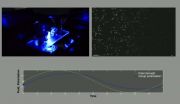Why good people do bad things
Anticipating temptation may improve ethical behavior, study finds
2015-06-05
(Press-News.org) Honest behavior is much like sticking to a diet. When facing an ethical dilemma, being aware of the temptation before it happens and thinking about the long-term consequences of misbehaving could help more people do the right thing, according to a new study.
The study, "Anticipating and Resisting the Temptation to Behave Unethically," by University of Chicago Booth School of Business Behavioral Science and Marketing Professor Ayelet Fishbach and Rutgers Business School Assistant Professor Oliver J. Sheldon, was recently published in the Personality and Social Psychology Bulletin. It is the first study to test how the two separate factors of identifying an ethical conflict and preemptively exercising self-control interact in shaping ethical decision-making.
In a series of experiments that included common ethical dilemmas, such as calling in sick to work and negotiating a home sale, the researchers found that two factors together promoted ethical behavior: Participants who identified a potential ethical dilemma as connected to other similar incidents and who also anticipated the temptation to act unethically were more likely to behave honestly than participants who did not.
"Unethical behavior is rampant across various domains ranging from business and politics to education and sports," said Fishbach. "Organizations seeking to improve ethical behavior can do so by helping people recognize the cumulative impact of unethical acts and by providing warning cues for upcoming temptation."
In one experiment, business school students were divided into pairs as brokers for the buyer and seller of a historic New York brownstone. The dilemma: The seller wanted to preserve the property while the buyer wanted to demolish it and build a hotel. The brokers for the seller were told to only sell to a buyer who would save the brownstone, while the brokers for the buyer were told to conceal the buyer's plan to develop a hotel.
Before the negotiations began, half of the students were asked to recall a time when they cheated or bent the rules to get ahead. Only 45 percent of those students thinking about their ethics ahead of time behaved unethically in the negotiations, while more than two-thirds, or 67 percent, of the students who weren't reminded of an ethical temptation in advance, lied in the negotiations in order to close the deal.
In another experiment involving workplace scenarios, participants were less likely to say it is okay to steal office supplies, call into work sick when they aren't really ill, or intentionally work slowly to avoid additional tasks, if they anticipated an ethical dilemma through a writing exercise in advance and if they considered a series of six ethical dilemmas all at once.
In other words, people are more likely to engage in unethical behavior if they believe the act is an isolated incident and if they don't think about it ahead of time.
The results of the experiments have the potential to help policy makers, educators and employers devise strategies to encourage people to behave ethically. For example, a manager could control costs by emailing employees before a work trip to warn them against the temptation to inflate expenses. The notice could be even more effective if the manager reminded employees that the urge to exaggerate expenses is a temptation they will encounter repeatedly in the future.
INFORMATION:
ELSE PRESS RELEASES FROM THIS DATE:
2015-06-05
This news release is available in German. Most magnetic materials have a structure that is somewhat more complicated than a commercially available domestic magnet: they not only have a north and south pole, but a variety of sectors, often only a few nanometres in size, in each of which the magnetic axis points in a different direction. These sectors are referred to as domains. Over the past few years, Manfred Fiebig, Professor for Multifunctional Ferroics at ETH Zurich, has been studying the walls between adjoining domains in certain materials. "The inner workings of ...
2015-06-05
When a woman becomes pregnant or is planning a pregnancy, one of her first decisions is where she will deliver her baby. With options ranging from birthing centers to small community hospitals to regional health networks to academic medical centers, the decision can be confusing.
The question, especially for a woman with a low-risk pregnancy, is "What is the likelihood that something could go wrong?"
Research on this topic has been published in the American Journal of Obstetrics & Gynecology. The research was conducted by Valery A. Danilack, MPH, PhD, postdoctoral ...
2015-06-05
Researchers from the UAB and the University of Nottingham, in an article published today in Physical Review Letters, have fixed the limits of thermometry, i.e., they have established the smallest possible fluctuation in temperature which can be measured. The researchers have studied the sensitivity of thermometers created with a handful of atoms, small enough to be capable of showing typical quantum-style behaviours.
The researchers characterised these types of probes in detail, devices which could provide an estimation of the temperature with a never before seen precision. ...
2015-06-05
June 5, 2015 - Young infants who can "resettle" themselves after waking up are more likely to sleep for prolonged periods at night, according to a video study in the June Journal of Developmental & Behavioral Pediatrics, the official journal of the Society for Developmental and Behavioral Pediatrics. The journal is published by Wolters Kluwer.
"Infants are capable of resettling themselves back to sleep by three months of age," according to the study by Ian St James-Roberts and colleagues of the University of London. They add, "Both autonomous resettling and prolonged ...
2015-06-05
Nanofibers -- polymer filaments only a couple of hundred nanometers in diameter -- have a huge range of potential applications, from solar cells to water filtration to fuel cells. But so far, their high cost of manufacture has relegated them to just a few niche industries.
In the latest issue of the journal Nanotechnology, MIT researchers describe a new technique for producing nanofibers that increases the rate of production fourfold while reducing energy consumption by more than 90 percent, holding out the prospect of cheap, efficient nanofiber production.
"We have ...
2015-06-05
One mystery of birds' flight is solved! The elegance of birds' flight, their seemingly effortless aerial turns and the softness of their landing, have been envied by many people. From countless observations, it has been known that the birds use a small group of feathers, called "the alula", a thumb-like structure that is present at the bend of the wing, in slow and steep flight such as landing. Why do they use it? How the tiny feathers can help them land softly?
A recent article published in Scientific Reports says that the secret is a small vortex of air that is formed ...
2015-06-05
Researchers from Uppsala University, together with colleagues at University College Dublin, have studied the dynamics of active swarms using computer simulations and experiments on unicellular algae. The team not only found full analogy of the active motion in a field to magnetic hysteresis but also managed to quantify the controllability of the swarm and identify the signatures of collective behavior of the active agents.
Active motion of living organisms and artificial self-propelling particles has been an
area of intense research at the interface of biology, chemistry ...
2015-06-05
Dublin, June 4th 2015 - Biochemists from Trinity College Dublin have devised a new technique that will make the difficult but critical job of blueprinting certain proteins considerably faster, cheaper and easier.
The breakthrough will make a big splash in the field of drug discovery and development, where precise protein structure blueprints can help researchers understand how individual proteins work. Critically, these blueprints can show weaknesses that allow drug developers to draw up specific battle plans in the fight against diseases and infections.
Professor ...
2015-06-05
Eye contact plays a crucial role when people initiate interaction with other people. If people look each other in the eye, they automatically send a signal that their attention is focused on the other person. If the other person happens to look back, the two will be in eye contact, and a channel for interaction is opened. Eye contact is thus a powerful social signal, which is known to increase our physiological arousal.
Previous research has suggested that eye contact triggers patterns of brain activity associated with approach motivation, whereas seeing another person ...
2015-06-05
Extremely poor vision can be caused by strabismus in early childhood or by a displaced optical axis. Amblyopia is caused not by organic damage to the eyes but by the brain incorrectly fitting together the images the eyes provide. As a result, the ability to see an object in sharp focus is severely limited. This occurs in more than one in 20 of the German population, as Heike M. Elflein et al. show in a recent original article in Deutsches Ärzteblatt International (Dtsch Arztebl Int 2015; 112(19): 338-44). The authors' study analyzed the visual acuity of over 3200 individuals ...
LAST 30 PRESS RELEASES:
[Press-News.org] Why good people do bad things
Anticipating temptation may improve ethical behavior, study finds


